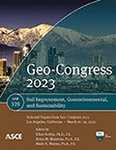Study on Crosslink-Induced Gelation of Xanthan Gum Biopolymer and Its Soil Strengthening Behavior as Sustainable Grout Material
Publication: Geo-Congress 2023
ABSTRACT
Biopolymer-based soil treatment (BPST) research has recently gotten much attention for environmentally friendly and sustainable soil treatment and ground improvement. The xanthan gum (XG) biopolymer, for example, has a high level of competitiveness due to its effective soil strengthening and hydraulic conductivity control properties. Even though XG improves soil strength by building tensile biofilms among soil grains, its high hydrophilicity causes rehydration of biofilms, resulting in a loss in strength in the presence of water. In this study, we used trivalent chromium cation (Cr3+) induced XG cross-linking to improve the strength and durability of XG-Cr3+-treated sands. The unconfined compressive strength and cohesion of sand are all increased by the time-dependent gelling effect in XG-Cr3+. Furthermore, XG-Cr3+ cross-linking shows sufficient improvement of the XG resistance to water exposure, resulting in increased durability even under long-term submergence. This study found that Cr3+ induced cross-linking enables to overcome challenges of pure XG-soil treatment, and XG-Cr3+-soil treatment can be utilized as grouting material since long-term strength can be achieved even underground without further dehydration and heat treatment.
Get full access to this article
View all available purchase options and get full access to this chapter.
REFERENCES
Apte, A. D., Tare, V., and Bose, P. (2006). “Extent of oxidation of Cr(III) to Cr(VI) under various conditions pertaining to natural environment.” J Hazard Mater, 128(2-3), 164–174.
ASTM. (2011). D3080/D3080M-11: Standard test method for direct shear test of soils under consolidated drained conditions. ASTM International, West Conshohocken, PA.
ASTM. (2016). D2166/D2166M-16 Standard Test Method for Unconfined Compressive Strength of Cohesive Soil. ASTM International, West Conshohocken, PA.
Ayeldeen, M. K., Negm, A. M., and El Sawwaf, M. A. (2016). “Evaluating the physical characteristics of biopolymer/soil mixtures.” Arabian Journal of Geosciences, 9(5), 1–13.
Baruthio, F. (1992). “Toxic effects of chromium and its compounds.” Biological trace element research, 32(1), 145–153.
Cabalar, A. F., Wiszniewski, M., and Skutnik, Z. (2017). “Effects of xanthan gum biopolymer on the permeability, odometer, unconfined compressive and triaxial shear behavior of a sand.” Soil mechanics and foundation engineering, 54(5), 356–361.
Chang, I., Im, J., and Cho, G. C. (2016). “Introduction of microbial biopolymers in soil treatment for future environmentally-friendly and sustainable geotechnical engineering.” Sustainability, 8(3), 251.
Chang, I., Im, J., Prasidhi, A. K., and Cho, G.-C. (2015). “Effects of Xanthan gum biopolymer on soil strengthening.” Constr. Build. Mater., 74(0), 65–72.
Chang, I., Im, J., Prasidhi, A. K., and Cho, G.-C. (2015). “Effects of xanthan gum biopolymer on soil strengthening.” Construction and Building Materials, 74, 65–72.
Chang, I., Kwon, Y.-M., Im, J., and Cho, G.-C. (2019). “Soil consistency and interparticle characteristics of xanthan gum biopolymer–containing soils with pore-fluid variation.” Canadian Geotechnical Journal, 56(8), 1206–1213.
Chen, R., Lee, I., and Zhang, L. (2015). “Biopolymer stabilization of mine tailings for dust control.” J. Geotech. Geoenviron. Eng., 141(2), 04014100.
Das, S. K., Mahamaya, M., Panda, I., and Swain, K. (2015). “Stabilization of pond ash using biopolymer.” Procedia Earth and Planetary Science, 11, 254–259.
Eary, L. E., and Rai, D. (1987). “Kinetics of chromium(III) oxidation to chromium(VI) by reaction with manganese dioxide.” Environmental Science & Technology, 21(12), 1187–1193.
Gales, J. R., Young, T. S., Willhite, G. P., and Green, D. W. (1994). “Equilibrium Swelling and Syneresis Properties of Xanthan Gum/Cr(III) Gels.” SPE Advanced Technology Series, 2(02), 190–198.
Garcı́a-Ochoa, F., Santos, V. E., Casas, J. A., and Gómez, E. (2000). “Xanthan gum: production, recovery, and properties.” Biotechnology Advances, 18(7), 549–579.
Gorny, J., Billon, G., Noiriel, C., Dumoulin, D., Lesven, L., and Madé, B. (2016). “Chromium behavior in aquatic environments: a review.” Environmental Reviews, 24(4), 503–516.
Kwon, Y.-M., Ham, S.-M., Kwon, T.-H., Cho, G.-C., and Chang, I. (2020). “Surface-erosion behaviour of biopolymer-treated soils assessed by EFA.” Géotechnique Letters, 10(2), 1–7.
Lee, M., Im, J., Chang, I., and Cho, G.-C. (2021). “Evaluation of Injection capabilities of a biopolymer-based grout material.” Geomechanics and Engineering, 25(1), 31–40.
Lentz, R. D. (2015). “Polyacrylamide and biopolymer effects on flocculation, aggregate stability, and water seepage in a silt loam.” Geoderma, 241, 289–294.
Mendonça, A., Morais, P. V., Pires, A. C., Chung, A. P., and Oliveira, P. V. (2020). “A review on the importance of microbial biopolymers such as xanthan gum to improve soil properties.” Applied Sciences, 11(1), 170.
Ni, J., Hao, G.-L., Chen, J.-Q., Ma, L., and Geng, X.-Y. (2021). “The optimisation analysis of sand-clay mixtures stabilised with xanthan gum biopolymers.” Sustainability, 13(7), 3732.
Ni, J., Li, S.-S., Ma, L., and Geng, X.-Y. (2020). “Performance of soils enhanced with eco-friendly biopolymers in unconfined compression strength tests and fatigue loading tests.” Construction and Building Materials, 263, 120039.
Nolte, H., John, S., Smidsrød, O., and Stokke, B. T. (1992). “Gelation of xanthan with trivalent metal ions.” Carbohydrate Polymers, 18(4), 243–251.
Orts, W. J., Sojka, R. E., and Glenn, G. M. (2000). “Biopolymer additives to reduce erosion-induced soil losses during irrigation.” Industrial Crops and Products, 11(1), 19–29.
Pelletier, E., Viebke, C., Meadows, J., and Williams, P. (2001). “A rheological study of the order–disorder conformational transition of xanthan gum.” Biopolymers: Original Research on Biomolecules, 59(5), 339–346.
Preuss, H. G., and Anderson, R. A. (1998). “Chromium update: examining recent literature 1997-1998.” Current Opinion in Clinical Nutrition & Metabolic Care, 1(6), 509–512.
Seo, S., Lee, M., Im, J., Kwon, Y.-M., Chung, M.-K., Cho, G.-C., and Chang, I. (2021). “Site application of biopolymer-based soil treatment (BPST) for slope surface protection: in-situ wet-spraying method and strengthening effect verification.” Construction and Building Materials, 307, 124983.
Zolfaghari, R., Katbab, A. A., Nabavizadeh, J., Tabasi, R. Y., and Nejad, M. H. (2006). “Preparation and characterization of nanocomposite hydrogels based on polyacrylamide for enhanced oil recovery applications.” Journal of Applied Polymer Science, 100(3), 2096–2103.
Information & Authors
Information
Published In
History
Published online: Mar 23, 2023
Authors
Metrics & Citations
Metrics
Citations
Download citation
If you have the appropriate software installed, you can download article citation data to the citation manager of your choice. Simply select your manager software from the list below and click Download.
